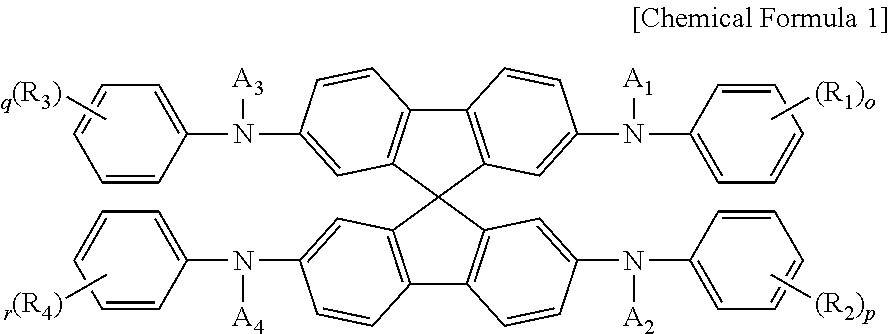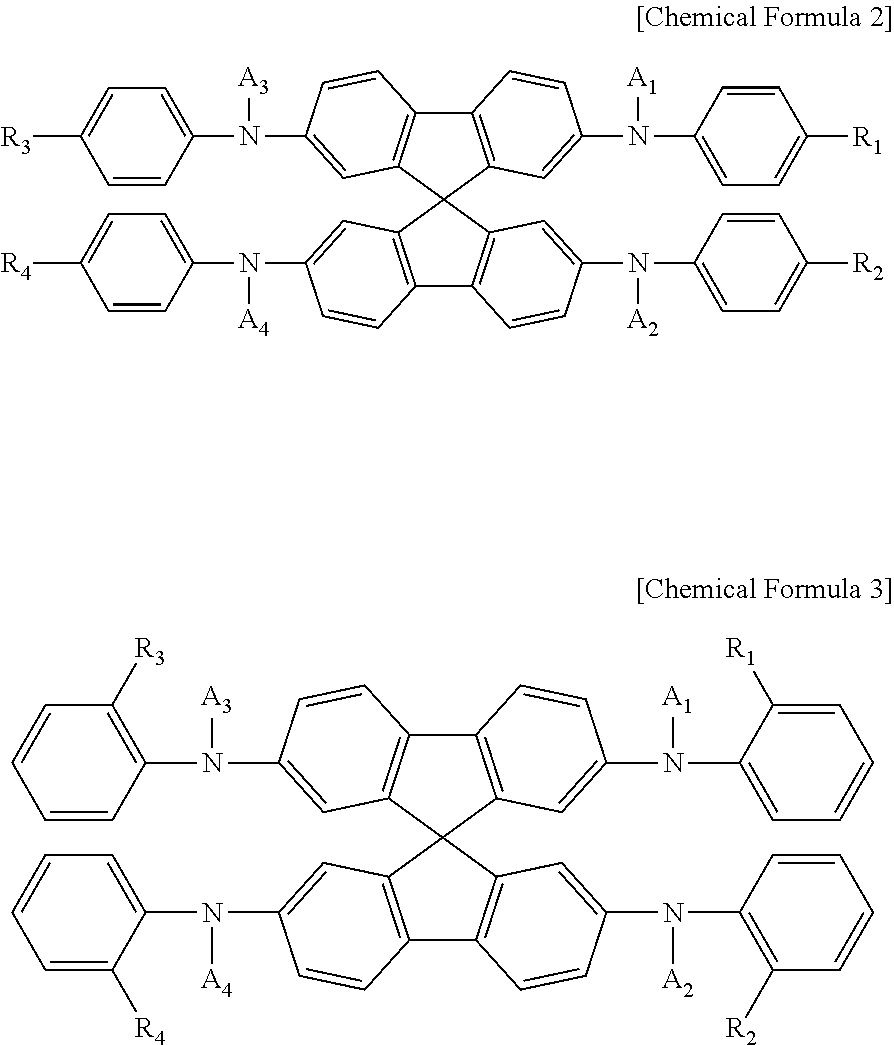Spirobifluorene compound and perovskite solar cell comprising same
a technology of solar cells and spirobifluorene, which is applied in the manufacture of final products, electrolytic capacitors, sustainable manufacturing/processing, etc., can solve the problems of reducing the manufacturing cost of solar cells, affecting the efficiency of solar cells, etc., to achieve the effect of improving efficiency, simple process and easy separation
- Summary
- Abstract
- Description
- Claims
- Application Information
AI Technical Summary
Benefits of technology
Problems solved by technology
Method used
Image
Examples
example 2
[Example 2] Preparation of Compound 2
[0111]
[0112]Tris(dibenzylideneacetone)dipalladium(0) (0.21 g, 0.2247 mmol), tri-tert-butylphosphine (0.09 g, 0.4495 mmol), and toluene (10 mL) were added to a 250 mL two-necked flask, and stirred for 10 minutes under a nitrogen atmosphere. 2-bromo-9,9-diphenylfluorene (1.49 g, 3.7455 mmol) and toluene (10 mL) were added thereto and stirred for 10 minutes, sodium tert-butoxide (0.65 g, 6.7419 mmol), Compound 1-1 (0.60 g, 0.7491 mmol), and toluene (15 mL) were added thereto and reacted at 130° C. for 30 hours. After completing the reaction, the reactant was extracted using ethyl acetate and NaCl water, and moisture was removed with MgSO4. Purification was performed with column chromatography (ethyl acetate / hexane=20%), and reprecipitation was performed using methylene chloride and hexane, thereby obtaining Compound 2 (0.79 g, 51%) in a powder form.
[0113]1H-NMR (Acetone, 400 MHz) δ=7.73 (d, 4H), 7.65 (d, 4H), 7.46 (d, 4H), 7.39 (d, 4H), 7.32 (t, 4H)...
example 3
[Example 3] Preparation of Compound 3
[0114]
[0115]Tris(dibenzylideneacetone)dipalladium(0) (0.46 g, 0.4994 mmol), tri-tert-butylphosphine (0.20 g, 0.9988 mmol), and toluene (20 mL) were added to a 250 mL two-necked flask, and stirred for 10 minutes under a nitrogen atmosphere. 2-bromo-9,9-spirobi[9H-fluorene] (2.47 g, 6.2425 mmol) and toluene (20 mL) were added thereto and stirred for 10 minutes, sodium tert-butoxide (1.08 g, 11.2365 mmol), Compound 1-1 (1 g, 1.2485 mmol), and toluene (30 mL) were added thereto and reacted at 130° C. for 30 hours. After completing the reaction, the reactant was extracted using ethyl acetate and NaCl water, and moisture was removed with MgSO4. Purification was performed with column chromatography (ethyl acetate / hexane=20%), and reprecipitation was performed using methylene chloride and hexane, thereby obtaining Compound 3 (2.02 g, 79%) in a powder form.
[0116]1H-NMR (Acetone, 400 MHz) δ=7.79 (t, 12H), 7.70 (d, 4H), 7.38 (d, 4H), 7.29 (t, 12H), 7.09 (t,...
example 4
[Example 4] Preparation of Compound 4
[0117]Preparation of Compound 4-1
[0118]Tris(dibenzylideneacetone)dipalladium(0) (0.87 g, 0.9494 mmol), tri-tert-butylphosphine (0.51 g, 1.8988 mmol), and toluene (20 mL) were added to a 250 mL two-necked flask, and stirred for 10 minutes under a nitrogen atmosphere. 2,2′,7,7′-Tetrabromo-9,9′-spirobi[9H-fluorene] (2 g, 3.1646 mmol) and toluene (20 mL) were added thereto and stirred for 10 minutes, sodium tert-butoxide (3.04 g, 31.64 mmol), o-anisidine (3.90 g, 31.6456 mmol), and toluene (30 mL) were added thereto and reacted at 130° C. for 30 hours. After completing the reaction, the reactant was extracted using ethyl acetate and NaCl water, and moisture was removed with MgSO4. Purification was performed with column chromatography (ethyl acetate / hexane=40%), and reprecipitation was performed using methylene chloride and hexane, thereby obtaining Compound 4-1 (2.06 g, 81%) in a powder form.
[0119]Preparation of Compound 4
[0120]Tris(dibenzylideneacet...
PUM
| Property | Measurement | Unit |
|---|---|---|
| Chemical Formula | aaaaa | aaaaa |
| Chemical | aaaaa | aaaaa |
| electric energy | aaaaa | aaaaa |
Abstract
Description
Claims
Application Information
 Login to View More
Login to View More - R&D
- Intellectual Property
- Life Sciences
- Materials
- Tech Scout
- Unparalleled Data Quality
- Higher Quality Content
- 60% Fewer Hallucinations
Browse by: Latest US Patents, China's latest patents, Technical Efficacy Thesaurus, Application Domain, Technology Topic, Popular Technical Reports.
© 2025 PatSnap. All rights reserved.Legal|Privacy policy|Modern Slavery Act Transparency Statement|Sitemap|About US| Contact US: help@patsnap.com



